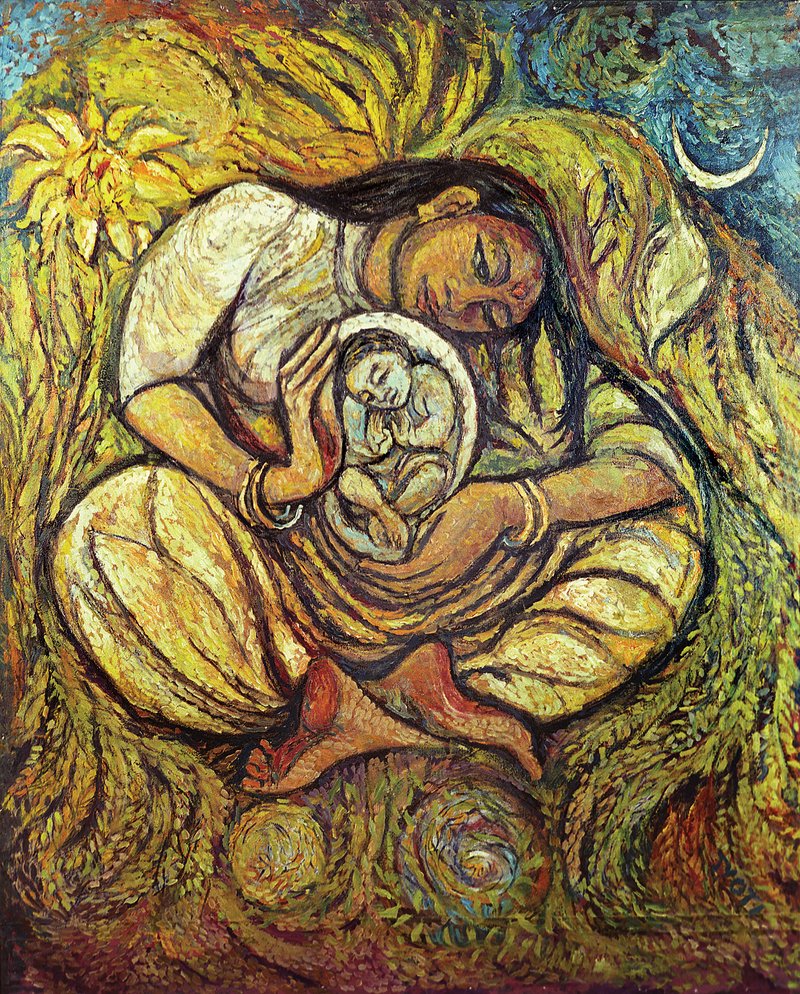
Dalit Madonna, c.2002
Jyoti Sahi (b.1944)
Oil on canvas, laid down on board, 148 x 119 cm. Methodist Modern Art Collection, MCMAC: 045
Image Copyright © Trustees for Methodist Church Purposes. The Methodist Church Registered Charity no. 1132208
Biblical commentary
Luke 2:7–10 Matthew2: 16 John 13:2b – 9, 12- 14 Matthew2: 1–2, 11
This image echoes the Indian folk symbol of the grinding stone, found in every traditional home. This has two parts. The larger “Mother Stone” is fixed and stable, whilst the smaller “Baby Stone” moves to grind food stuffs on the Mother Stone. Relating Mary and Jesus to this symbol links the bond between them to the preparation of daily bread on the grinding stone so we can think of it when saying “Give us this day our daily bread”. “Dalit” means broken (sometimes used by those in South Asia traditionally regarded as low caste or ‘untouchable’). Breaking items on the grinding stone is necessary to create wholesome food for the family. The suffering in the relationship of Jesus and Mary is necessary to create life and hope.
Commentary based on A Guide to the Methodist Art Collection.
Artist biography
Born: Pune, India, 1944
Early life and education
Jyoti Sahi was born in Pune in India and brought up in Dehradun, where both his parents were teachers. His parents were Hindu, but he and his mother converted to Christianity when Sahi was 14 years old. He was inspired by a family friend to become an artist and at the age of 15 he went to London to study at the Camberwell School of Arts and Crafts (1959-63).
Life and career
Sahi returned to India to teach art but in 1964 he joined Dom Bede Griffiths in his newly-founded Christian ashram in South India. Father Bede’s dream was to set up a community of artists and craftspeople, drawing on the tradition of the close association of monasteries with icon painters. There, Sahi met his wife, Jane, a Quaker from Birmingham, and Fr Bede married them in Shantivanam Ashram in 1970. In 1972 Sahi and Jane moved to Silvepura village, north Bangalore, where they have lived since. They have five children. Jane founded a school for local children there.
Sahi became connected with the National Biblical, Catechetical and Liturgical Centre, founded by the Catholic Bishops Conference of India soon after the Second Vatican Council. This centre sought to relate the Church in India to Indian cultures and spirituality. It also reflected the Indian Church’s concern to free itself from its colonial past. Sahi founded an art ashram there, the Indian School of Art for Peace in Silvepura, North Bangalore in 1984, and continues to create art there and teach Indian and Asian aesthetics.
Sahi states that ashrams are places, communities, or a stage of life, defined by a spiritual search. Christian ashrams have become important centres for thinking about Indian liturgy, using traditional Indian symbols, music and gestures, and understanding of sacramental life. Sahi follows this approach in his paintings, using traditional Indian symbols as a way of reflecting on and understanding his Christian faith. In her blogs Victoria Emily Jones, a researcher on Christianity and the Arts and a friend of the artist, describes how he creates images of Jesus as an Indian and how his work opens up dialogue between Christian, Hinduism and Adivasi (tribal) cultures. She regards him as “one of the most theologically exploratory artists working today”.
Exhibitions and collections
Exhibitions of Sahi’s work include, in the 1980s: the Heras Institute, Bombay; and Healing Wings at the Mission Hospital, Würzburg, Germany; and in the 2000s: Faces of Jesus (organised by Christians Aware) at various venues in the UK concluding in Southwell Minster.
His commissions in India include in the 1960s/70s: Stations of the Cross, mosaics for churches in Lottar Diocese, Nagercoil district, Tamil Nadu; in the 1970s/80s: a painting of Jesus at the Well with the Samaritan Woman for Sister Vandana’s chapel in Jeevan Dhara Ashram, Rishikesh; and in the 1990s: window designs for the new cathedral in Benares.
Sources and further reading
Interview in the Church Times by Terence Handy MacMath, Jyoti Sahi, artist: churchtimes.co.uk/articles/2022/17-june/features/interviews/interview-jyoti-sahi-artist
Blog by Victoria Emily Jones, ‘Jesus as Ladder: Jyoti Sahi and Ralph Stanley in conversation with Genesis 28’, (27 June 2016). artandtheology.org/2016/06/27/jesus-as-ladder-jyoti-sahi-and-ralph-stanley-in-conversation-with-genesis-28/
Blog by Victoria Emily Jones, ‘Jesus as Dancer: Jyoti Sahi’s “Lord of Creation”’ (19 October 2020), sojourn-arts.com/blog/2020/10/7/jesus-as-dancer-jyoti-sahis-lord-of-creation
Blog by Victoria Emily Jones, ‘Easter sermon by Saint Ephrem (excerpt) + triptych by Jyoti Sahi’ (23 April 2023), artandtheology.org/tag/jyoti-sahi/
Eric Lott and Jyoti Sahi, Faces of Vision, (Leicester: Christians Aware, 2008).
Jyoti Sahi, Stepping Stones: Reflections on the Theology of Indian Christian Culture, (Asian Trading Corporation, 1986).
Seeing the Spiritual: A Guide to the Methodist Modern Art Collection, (Oxford, 2018), P. 98-99.